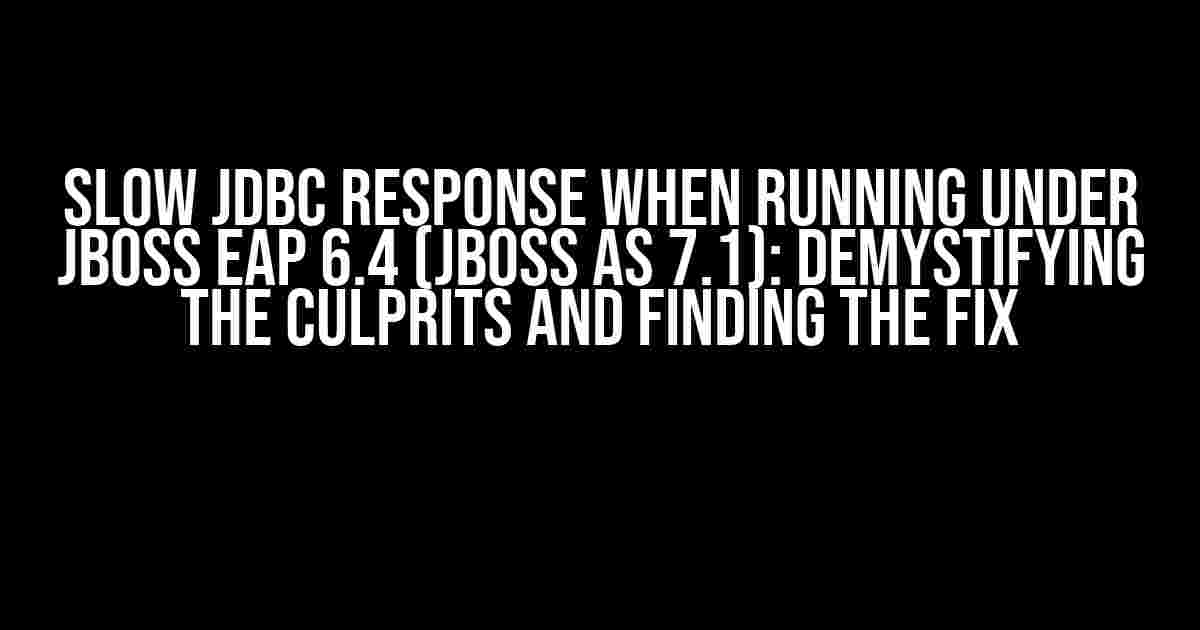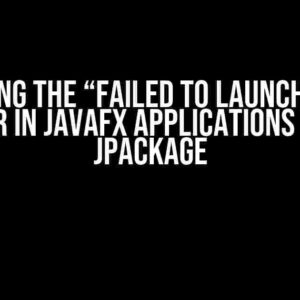Introduction
If you’re reading this article, chances are you’re frustrated with the slow JDBC response time when running your application under JBoss EAP 6.4 (JBoss AS 7.1). You’re not alone! Many developers have reported this issue, and it’s about time we get to the bottom of it. In this comprehensive guide, we’ll explore the culprits behind this pesky problem and provide you with actionable steps to optimize your JDBC performance.
Understanding the Problem
Before we dive into the solutions, let’s first understand what’s causing the slow JDBC response time. Here are some possible reasons:
- Connection Pooling Issues: Improperly configured connection pooling can lead to slow response times. JBoss EAP 6.4 uses the IronJacamar connection pooling mechanism, which can be finicky at times.
- Transaction Isolation Levels:Incorrectly configured transaction isolation levels can cause performance bottlenecks.
- Database Connectivity Issues: Poor database connectivity can result in slow responses. This might be due to network latency, firewall issues, or database configuration problems.
- Resource Constraints: Insufficient resources, such as CPU, memory, or I/O, can slow down your application’s performance.
Diagnosing the Issue
Before we start optimizing, let’s identify the root cause of the problem. Follow these steps to diagnose the issue:
- Enable JDBC Logging: Enable JDBC logging in your application to gather more information about the slow responses. You can do this by adding the following configuration to your
standalone.xmlfile:<subsystem xmlns="urn:jboss:domain:logging:3.0"> <logger category="com.arjuna.ats.jta"> <level name="DEBUG"/> </logger> </subsystem> - Analyze JVM GC Logs: Analyze the JVM garbage collection logs to identify any potential memory-related issues. You can enable GC logging by adding the following JVM arguments:
-Xlog:gc*:file=gc.log:etime,utctime,tags:filecount=10,filesize=1024k
- Monitor System Resources: Use tools like
top,htop, orvmstatto monitor system resources like CPU, memory, and I/O usage. - Check Database Performance: Use database monitoring tools to check the performance of your database. Identify any bottlenecks, such as slow queries or high disk I/O.
Optimizing JDBC Performance
Now that we’ve diagnosed the issue, let’s dive into the optimization techniques:
1. Connection Pooling Optimization
IronJacamar provides several configuration options to optimize connection pooling. Here are some tweaks to try:
- Min Pool Size: Set the minimum pool size to a lower value to reduce the overhead of creating new connections.
<min-pool-size>5</min-pool-size> - Max Pool Size: Set the maximum pool size to a higher value to handle increased load.
<max-pool-size>50</max-pool-size> - Pool Flush Interval: Set the pool flush interval to a lower value to remove idle connections more frequently.
<flush-interval>300</flush-interval>
2. Transaction Isolation Level Optimization
Adjust the transaction isolation level to optimize performance:
- READ_COMMITTED: Use the READ_COMMITTED isolation level to reduce locking overhead.
<transaction-isolation>READ_COMMITTED</transaction-isolation> - READ_UNCOMMITTED: Use the READ_UNCOMMITTED isolation level if you’re dealing with high-concurrency read operations.
<transaction-isolation>READ_UNCOMMITTED</transaction-isolation>
3. Database Connectivity Optimization
Optimize database connectivity by:
- Tuning Network Settings: Adjust network settings, such as socket timeout and connection timeout, to improve database connectivity.
<socket-timeout>30000</socket-timeout>
<connection-timeout>30000</connection-timeout> - Enabling Connection Keep-Alive: Enable connection keep-alive to reduce the overhead of establishing new connections.
<keep-alive>true</keep-alive>
4. Resource Constraints Optimization
Optimize system resources by:
- Increasing JVM Heap Size: Increase the JVM heap size to reduce garbage collection pauses.
-Xmx1024m - Adjusting Thread Pool Sizes: Adjust thread pool sizes to optimize concurrency and reduce overhead.
<thread-pool>50</thread-pool>
Conclusion
Solving slow JDBC response times under JBoss EAP 6.4 (JBoss AS 7.1) requires a combination of diagnosis and optimization techniques. By following the steps outlined in this article, you should be able to identify and fix the culprits behind the slow response times. Remember to monitor system resources, database performance, and JDBC logging to ensure your application is performing optimally.
Additional Resources
For further reading, check out the following resources:
| Tuning Parameter | Description | Default Value |
|---|---|---|
| min-pool-size | Minimum pool size | 5 |
| max-pool-size | Maximum pool size | 50 |
| flush-interval | Pool flush interval | 300 |
| transaction-isolation | Transaction isolation level | READ_COMMITTED |
| socket-timeout | Socket timeout | 30000 |
| connection-timeout | Connection timeout | 30000 |
| keep-alive | Connection keep-alive | true |
Note: The values mentioned in the table are examples and may vary depending on your specific use case.
Frequently Asked Question
If you’re experiencing slow JDBC response when running under JBoss EAP 6.4 (JBoss AS 7.1), don’t worry, we’ve got you covered! Check out these frequently asked questions and answers to help you troubleshoot and resolve the issue.
What is the main reason behind slow JDBC response in JBoss EAP 6.4?
The main reason behind slow JDBC response in JBoss EAP 6.4 is the default configuration of the datasource, which is set to use the Java Transaction API (JTA) by default. This can cause performance issues, especially in high-traffic environments.
How can I optimize the datasource configuration to improve JDBC response?
To optimize the datasource configuration, you can try changing the transaction mode from JTA to LOCAL, and setting the connection pool to use a more efficient algorithm, such as the “prefill” algorithm. You can also consider increasing the connection pool size and adjusting the idle timeout.
What are some common pitfalls to avoid when configuring JDBC in JBoss EAP 6.4?
Some common pitfalls to avoid when configuring JDBC in JBoss EAP 6.4 include not setting the correct transaction isolation level, not using prepared statements, and not properly closing JDBC resources. Additionally, failing to monitor and adjust the connection pool and statement cache can also lead to performance issues.
How can I troubleshoot JDBC performance issues in JBoss EAP 6.4?
To troubleshoot JDBC performance issues in JBoss EAP 6.4, you can enable JDBC logging, use profiling tools such as VisualVM or YourKit, and analyze the JBoss EAP 6.4 server logs to identify bottlenecks. You can also use tools like JConsole or VisualVM to monitor the application’s memory usage and CPU utilization.
Are there any third-party tools or libraries that can help improve JDBC performance in JBoss EAP 6.4?
Yes, there are several third-party tools and libraries that can help improve JDBC performance in JBoss EAP 6.4, such as connection pool libraries like C3P0 or BoneCP, and JDBC proxy drivers like P6Spy or log4jdbc. Additionally, tools like Hibernate or MyBatis can also help improve JDBC performance by providing additional features and optimizations.


